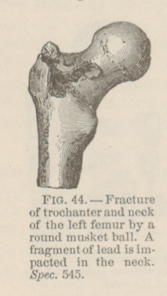Title: R——, Alfred G.
Source text: The Medical and Surgical History of the War of the Rebellion. (1861-65.), Part 3, Volume 2 (Washington, DC: Government Printing Office, 1883), 85-86.
Civil War Washington ID: med.d2e4678
TEI/XML: med.d2e4678.xml
CASE 191.— "Alfred G. R——, Adjutant 134th Pennsylvania, aged 24 years, was wounded in the upper part of the left femur by a round ball, which partially fractured the trochanter major, at the battle of Fredericksburg, December 13, 1862. The wound received no attention for some days, and was then dressed with side splints firmly bound by a roller, a plug of lint being tightly inserted in the wound. On the 20th of December he was admitted to E Street Infirmary, Washington. He stated that for some days he had experienced occasional twitchings in the limb, and had taken large doses of opium. The wound was a little behind the trochanter major. Upon removing the plug of lint about half a pint of blood and pus was discharged. There was no crepitus upon rotation, nor shortening. Owing to his weakened condition, no extended search was made for the missile. Simple dressings were applied, and half grain doses of sulphate of morphia were given. For the two succeeding days he seemed to improve. The twitchings of the limb occurred every few minutes, with occasional intermissions of a few hours. On the 23d the spasms became more violent and frequent, and it was deemed advisable to extract the missile. He was etherized, and the wound was enlarged two inches downward and backward. A gum catheter was made to follow the course of the missile behind and beneath the neck of the femur to the body of the pubis, where the ball was found in the scrotum near the spermatic cord. A flattened round musket ball was extracted through an incision at the base of the scrotum. A portion of it had been chipped off. The patient rested well that night, but on the following day the spasms were increased in intensity, commencing in the injured limb and extending over the body. Cloths saturated with chloroform and olive oil were applied to the limb, and an antispasmodic and anodyne mixture was prescribed. He rested quietly until the following morning, when clonic spasms returned and persistently increased. The patient's countenance became pinched, wan, and haggard, and expressive of fright. There was no pain nor trismus, and he partook freely of nouishment. At times there was complete opisthotonos. On December 25th he took four dozen pills of assafœtida of four grains each, and one half ounce of fluid extract of Cannabis Indica in divided doses, without any benefit. Sulphate of morphia in doses of one grain was then prescribed, to be administered every two hours, and a poultice of powdered opium and cinchona applied to the wound, but, as before, without apparent benefit. The mind, up to this time, continued clear and undisturbed, his pulse moderately full and strong, ranging at about 100. He now became drowsy, and at times lay in a semi-comatose condition. His pulse ran up to 150. Respiration was free, but at times hurried, from 25 to 28 per minute. The skin became bathed in sweat, which exhaled a peculiar pungent odor. The bowels were regular; the urine was scantily secreted and high colored, though voided without difficulty. The discharge from the wound was thin, bloody, and offensive. On December 27th opisthotonos recurred, and was temporarily relieved by the application of chloroform to the entire extent of the spine. Subsequently, violent epileptiform convulsions set in, and death resulted from exhaustion, on December 28, 1862." The pathological specimen is figured in the wood-cut (FIG. 44) and shows a fracture of the great trochanter of the left femur and a piece of a leaden ball embedded in the neck. The specimen and history were contributed by Surgeon C. L. Allen, U. S. V.—(Circular 2, S. G. O., 1869, p.80. CASE 94.)
